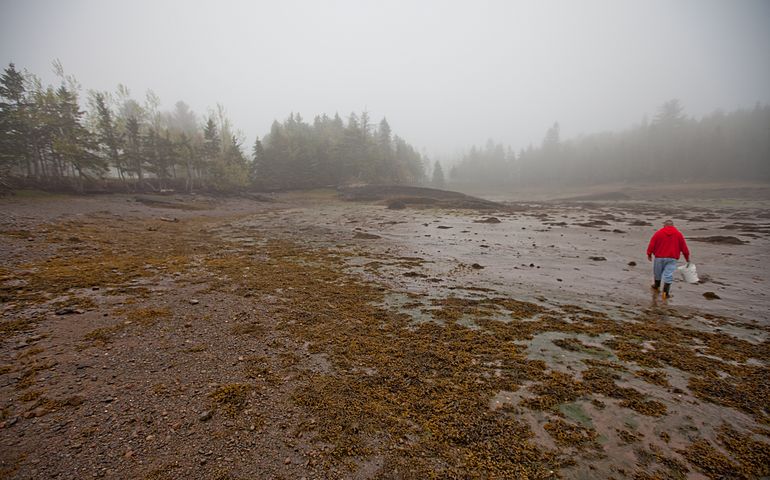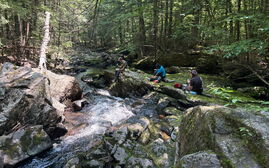
Coastal access, climate change key as Maine Coast Heritage Trust turns 50
 Courtesy / Bridget Besaw, Maine Coast Heritage Trust
A clammer gets to work at the Sipp Bay Preserve in Perry, land protected by the Maine Coast Heritage Trust. The organization, which is celebrating its 50th annivesary, says access for clammers and others who make a living from the sea is increasingly important.
Courtesy / Bridget Besaw, Maine Coast Heritage Trust
A clammer gets to work at the Sipp Bay Preserve in Perry, land protected by the Maine Coast Heritage Trust. The organization, which is celebrating its 50th annivesary, says access for clammers and others who make a living from the sea is increasingly important.
Maine Coast Heritage Trust started small 50 years ago, with a mission to protect the views for Acadia National Park visitors.
The Topsham-based organization now protects 154,000 acres along Maine's coast, about 38,000 acres of which it owns or has easements on, and has 60 employees. As it celebrates its anniversary, its mission, which has evolved over the years, is in many ways the same, but with a more intense focus.
Fresh off the heels of raising $125 million, the challenge is still to protect the environment, with an emphasis on community that's increased over the past decade, Tim Glidden, president of Maine Coast Heritage Trust, told Mainebiz. But access for clammers, fishermen and farmers, as well as new strategies to protect areas that will be affected by rising sea water and temperatures, as well as mitigating some of the effects of climate change, are at the forefront.
Partnerships with other trusts, as well as town and city governments, are key to the trust's efforts. "There's a lot more that needs to be done," he said.
Land conservation efforts by the organization have increasingly taken community strength and health into account, as much as the environment, and conservation's overall impact on the state's economic foundation. As the climate changes, that focus is more important than ever, he said.
Included in the land protected by Maine Coast Heritage Trust are more than 125 public preserves, 325 islands and more than 90 miles of trails. The trust also established the the Maine Land Trust Network, which works with Maine’s 80-plus local land trusts.
An economic development strategy
Glidden said land conservation is ultimately an economic development strategy. Even the trust's partnership on a 4.5-acre community farm in Milbridge, where residents can help themselves to vegetables, makes a difference.
"It's not economic development by itself, but it's important to the nutrition and health of folks in a rural community," he said. "It's helping to create a strong, more resilient workforce."
Projects by the trust range from that small one, which was in partnership with the Women's Health Resource Library, to helping Lubec with land acquisition for a $19 million BUILD-grant financed wharf project now being celebrated by U.S. Sen. Susan Collins on one of her campaign ads.
Land conservation is often thought of as "bucks and acres," he said. Money gets raised, land gets bought. The Milbridge project "isn't a lot of land, and it didn't cost a lot of money."
It's something that, a couple decades ago, the trust wouldn't have even considered. But a community focus that began about 15 years ago in the organization as it looked at how to engage more with coastal communities became official in 2014, when the board made it part of its strategy, equal to protecting the environment, he said.

Seeing the value
Conservation is "about all life, human life and the natural world," Glidden said. But it's also an abstract concept to most people "unless they can see its value."
"It may not be a top priority, it may even be thought as something to be a little threatened by," he said. "But poll after poll after poll in Maine, across all political spectrums, and social spectrums, shows that 80% to 90% of Maine's residents want to protect the natural elements that make Maine so special."
The trust worked with 45 coastal towns last year, and frequently partners with other trusts or agencies on conservation efforts that aren't part of land owned or protected by the trust itself.
Initially, 50 years ago, preserving coastal access was prompted by concerns about development sprawl, he said. That became less of a concern as time passed, but access issues now surround preserving the areas where the state's clammers, fishermen, lobstermen and others make their living, as well as providing an inviting atmosphere for tourists and the state's residents.
One of the biggest threats to access, Glidden said, is climate change. Not only will rising seas eat up shoreline, but as the eastern seaboard warms, up more visitors and residents may flock to Maine's cooler temperatures.
It's anticipated that 75% of Maine’s native plants and animals are at risk with rising temperature and ocean, he said. The trust's programs going forward are to make the coast more resilient.
"Continued strategic land conservation is a critical part of assuring a sustainable Maine coast," he said. "Land conservation is known to be one of the most effective solutions for adapting to and mitigating the impact of climate change."
$125 million campaign completed
In December, MCHT completed a $125 million six-year campaign that comprised more than 7,500 donors. "During that time," the trust said, "the breadth and pace of land conservation work increased."
Highlights over the past few years include:
- Working with Lubec to jump-start a $19 million project to create a safe harbor for their commercial fishermen and recreational boaters.
- Conservation of 11,000 acres, 55 miles of shoreline, and 22 entire coastal islands, including "iconic locations," such as the Goslings Islands in Casco Bay, the Stone Barn Farm on Mount Desert Island, Long Point in Machiasport and Woodward Point in Brunswick.
- Successful projects restoring fish passage in the Bagaduce River watershed on the Blue Hill Peninsula.
- Strengthening MCHT’s capacity to manage and maintain 38,000 acres of conserved lands and continuing to improve visitor experiences and access to coastal preserves.
- Establishing a “Marshes for Tomorrow” initiative to mitigate and adapt to the impacts of rising seas. Salt marshes clean the air and water, protect our towns from storm surge, and are nurseries for dozens of species, including lobster. Protecting salt marshes and lands surrounding them is a top priority, the trust said.
- Connecting more than 20,000 people of all ages to the coast through special events and programs including outing clubs, agricultural programming for kids and teens, and field trips and community gatherings.













0 Comments